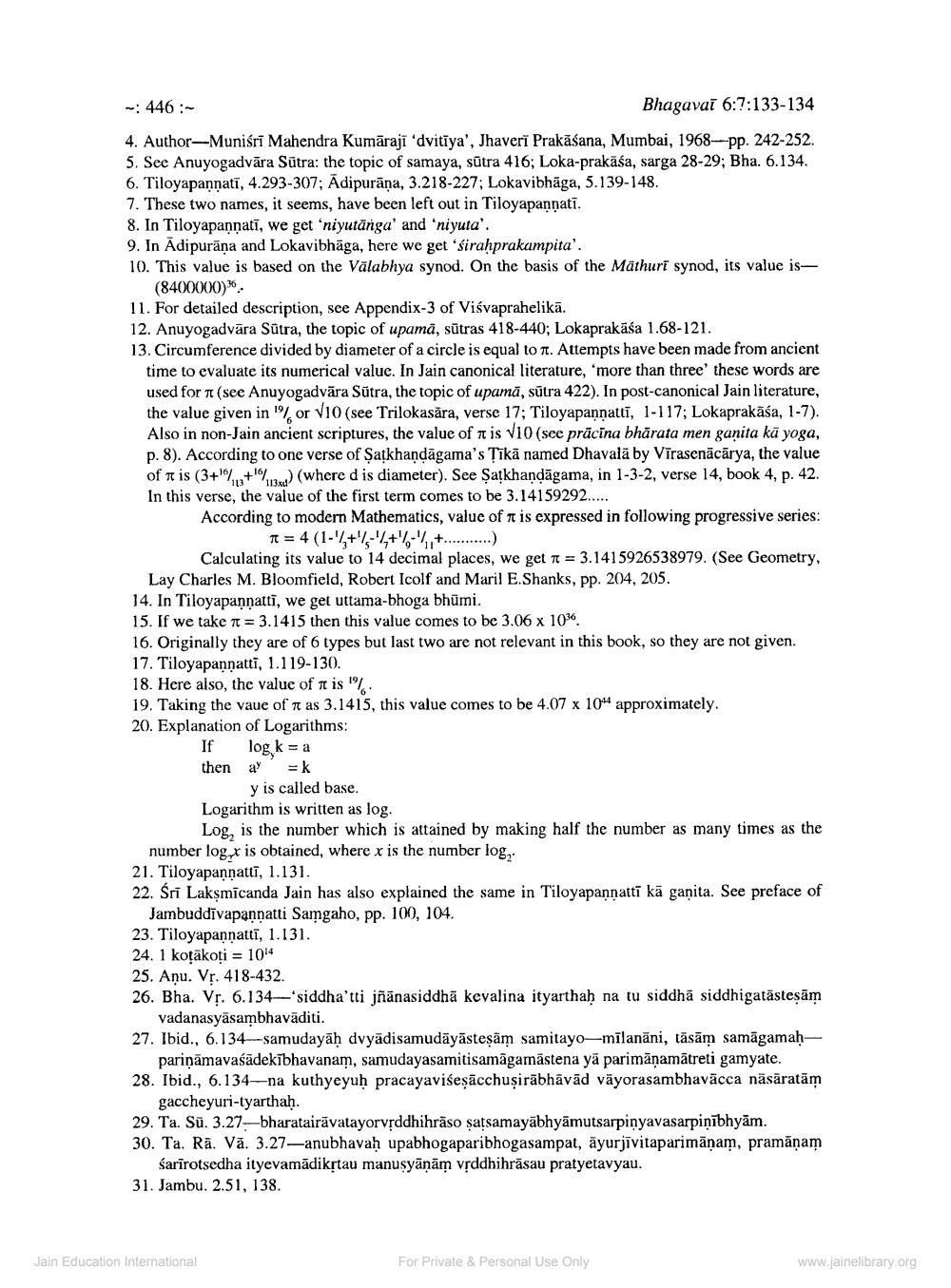________________
~:446:~
Bhagavai 6:7:133-134
4. Author-Muniśrī Mahendra Kumārajī 'dvitīya', Jhaveri Prakāśana, Mumbai, 1968-pp. 242-252.
5. See Anuyogadvāra Sutra: the topic of samaya, sūtra 416; Loka-prakāśa, sarga 28-29; Bha. 6.134. 6. Tiloyapanṇatī, 4.293-307; Adipuraṇa, 3.218-227; Lokavibhāga, 5.139-148.
7. These two names, it seems, have been left out in Tiloyapanṇatī.
8. In Tiloyapanṇali, we get 'niyutänga' and 'niyuta.
9. In Adipurāṇa and Lokavibhāga, here we get 'siraḥprakampita'.
10. This value is based on the Välabhya synod. On the basis of the Mathurī synod, its value is(8400000).
11. For detailed description, see Appendix-3 of Viśvaprahelikā.
12. Anuyogadvāra Sutra, the topic of upama, sūtras 418-440; Lokaprakāśa 1.68-121.
13. Circumference divided by diameter of a circle is equal to л. Attempts have been made from ancient time to evaluate its numerical value. In Jain canonical literature, 'more than three' these words are used for л (see Anuyogadvāra Sutra, the topic of upamā, sūtra 422). In post-canonical Jain literature, the value given in 1% or √10 (see Trilokasära, verse 17; Tiloyapannatti, 1-117; Lokaprakāśa, 1-7). Also in non-Jain ancient scriptures, the value of it is V10 (see prācīna bhārata men ganita kā yoga, p. 8). According to one verse of Satkhanṇḍāgama's Tīkā named Dhavala by Virasenācārya, the value of π is (3+1+16/ 113x) (where d is diameter). See Ṣatkhanḍāgama, in 1-3-2, verse 14, book 4, p. 42. In this verse, the value of the first term comes to be 3.14159292.....
According to modern Mathematics, value of is expressed in following progressive series: x=4(1-+-+-+)
11
Calculating its value to 14 decimal places, we get л = 3.1415926538979. (See Geometry,
Lay Charles M. Bloomfield, Robert Icolf and Maril E.Shanks, pp. 204, 205.
14. In Tiloyapanṇatti, we get uttama-bhoga bhūmi.
15. If we take π = 3.1415 then this value comes to be 3.06 x 1036.
16. Originally they are of 6 types but last two are not relevant in this book, so they are not given. 17. Tiloyapanṇatti, 1.119-130.
18. Here also, the value of it is "
19. Taking the vaue of π as 3.1415, this value comes to be 4.07 x 104 approximately.
20. Explanation of Logarithms:
If log, k = a then a =k
y is called base.
Logarithm is written as log.
Log, is the number which is attained by making half the number as many times as the
number log,x is obtained, where x is the number log,
21. Tiloyapanṇatti, 1.131.
22. Śrī Lakṣmicanda Jain has also explained the same in Tiloyapanṇattī kā gaṇita. See preface of Jambuddivapunnatti Samgaho, pp. 100, 104.
23. Tiloyapanṇatti, 1.131.
24. 1 kotākoți
1014
25. Aņu. Vr. 418-432.
26. Bha. Vr. 6.134-'siddha'tti jñānasiddhā kevalina ityarthaḥ na tu siddhā siddhigatasteṣām vadanasyasambhavaditi.
27. Ibid., 6.134-samudayaḥ dvyädisamudāyāsteṣām samitayo-milanäni, tāsām samägamaḥ pariņāmavasidekibhavanam, samudayasamitisamāgamastena yā parimāṇamātreti gamyate.
28. Ibid., 6.134—na kuthyeyuḥ pracayaviseṣacchuṣirābhāvād vāyorasambhavācca nāsāratām gaccheyuri-tyarthah.
Jain Education International
29. Ta. Sü. 3.27-bharatairavatayorvṛddhihrāso satsamayabhyamutsarpinyavasarpiņibhyām. 30. Ta. Rä. Vä. 3.27-anubhavaḥ upabhogaparibhogasampat, äyurjīvitaparimäņam, pramāņam śarīrotsedha ityevamādikṛtau manuṣyāṇām vṛddhihrāsau pratyetavyau.
31. Jambu. 2.51, 138.
For Private & Personal Use Only
www.jainelibrary.org




